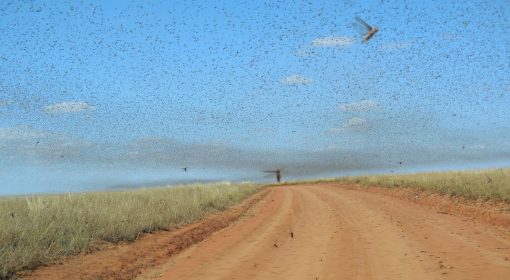The desert locust can migrate long distances and can voraciously feed on key staple crops like maize which can adversely impact the livelihoods of farmers and result in food insecurity. It is therefore essential to identify the breeding grounds before they turn into gregarious swarms so that their growth can be controlled.
The intensity and the frequency of the locust outbreak depends a lot on weather patterns. Studies have found a link between soil moisture, soil type, sand content, temperature, land cover and rainfall; and the growth of locust species. In areas where locust attacks have been less frequent, there is significantly less data available that can aid in the proper management of locust. It is therefore imperative to gather information on locusts’ egg-laying and breeding so that surveillance can be strengthened and regional coordination can be improved to prevent the damage caused by the locusts.

Researchers at International Centre of Insect Physiology and Ecology (ICIPE), have undertaken a study to predict the breeding sites of locusts by making use of a mathematical models. They have used key bio-climatic factors like (temperature and rainfall) and bio-physical (sand and moisture contents) elements in the Ecological Niche (EN) model approach to identify the potential breeding sites in East Africa.
Using EN approach, sites of locust outbreak have been predicted. By using mathematical models a set of environmental conditions was correlated to species’ presence or absence data, to predict its suitable habitats.
The model has helped predict suitable habitats for desert locusts by:
1) establishing what conditions are conducive to locust breeding and growth, and
2) identifying areas in East Africa with similar conditions
As a result, it has helped in the development of a decision support tool for policymakers who want to control and manage the population of locusts.
So by modelling the relationship between bio-climatic factors like temperature, rainfall and soil-related factors like soil moisture etc. with the known desert locust sites around the world, potential breeding sites in the East African region was predicted.
The model found that many regions in Kenya and Sudan, north eastern areas of Uganda and south eastern and the northern regions of South Sudan are at a higher risk of providing a conducive breeding environment for the desert locust.
Models like the Ecological Niche approach have proven to be very useful for projections and modelling data. Since they are based on secondary data sources, they promote the idea of reusing data and are not depended on any primary field data. A way forward for modelling tools that use agro-climatic data can be the use of WAPOR database.
WaPOR is an open-source data set created by FAO to improve the agricultural and water management practices in the African continent. Further research could be undertaken to understand how the data available in WaPOR could enable prediction of locust sites. For example, using the same variables as used in the EN approach model like temperature, soil moisture, soil type, and rainfall, WaPOR could help in designing of a similar decision support tool. It will be interesting to see how availability of such open source data can strengthen the existing research on locusts and help in managing their growth.
Based on the presentation by Emily Kimathi, International Centre of Insect Physiology and Ecology (icipe), at the 1st Virtual Practitioners Conference on Desert Locust Management 2020



